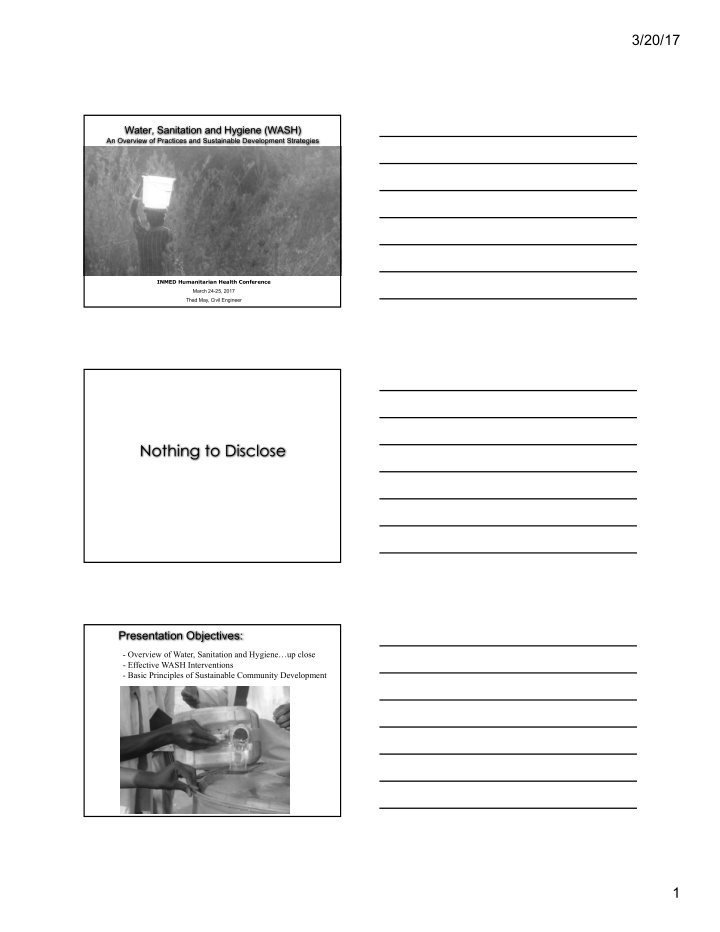



3/20/17 Water, Sanitation and Hygiene (WASH) An Overview of Practices and Sustainable Development Strategies INMED Humanitarian Health Conference March 24-25, 2017 Thad May, Civil Engineer Nothing to Disclose Presentation Objectives: - Overview of Water, Sanitation and Hygiene…up close - Effective WASH Interventions - Basic Principles of Sustainable Community Development 1
3/20/17 WASH Benefits of WASH 2
3/20/17 Water Facts • 663 million people lack access to an improved water source (approx 1 in 11 people). • 2.4 billion people lack access to adequate sanitation (33%) Unicef, 2015 Water Facts • 3.4 million people die each year from water, sanitation, and hygiene-related causes. • Nearly all deaths, 99 percent, occur in the developing world 3
3/20/17 Water Facts • Every 21 seconds a child dies from a water related disease developing world • ~90 percent of diarrheal related deaths occur among children under 5 years of age • 1,800 child deaths/day caused by unsafe water Field Internship Livingstone, Zambia near Victoria Falls Living in the Village 4
3/20/17 Moving into the Neighborhood Singanga, Village Southern Province Home away from home Our Observations: People were drinking untreated river water… 5
3/20/17 …while the village BioSand Filters went unused… …not used for filtering water, anyway. A reason: “This water from the river…it can be good water” 6
3/20/17 Open defecation was common… …yet pit latrines were available Would you use this latrine? 7
3/20/17 Our first order of business: Install a BioSand filter & composting pit latrine Our Fancy Loo Question: How to change behavior and attitudes about clean water & sanitation? 8
3/20/17 A single gram of human feces contains... Waterborne Diseases * UNICEF REPORT - 2013 Sanitation is the most off-target Millennium Development Goal 9
3/20/17 The single most important invention improving health in the last 200 years! The burden of finding water falls especially on women… …and girls. 10
3/20/17 Walking and perhaps waiting for water … 3 or 4 hours a day? Relief vs. Development ? Relief: Aid done for people (Assistance during a crisis) Development: Aid done with People (Empowering communities in the process) 11
3/20/17 Definitions Relief : Urgent provision of emergency aid to reduce immediate suffering during a crisis. Short-term, Outside resourced Development : Community is empowered to identify and solve their own problems with local resources. Results are long-term, sustainable. Core Principal of Community Development: Respect the locals as the experts of their own culture. Telling ourselves the Truth “Here’s the truth: Giving to those in need what they could be gaining from their own initiative may well be the kindest way to destroy people.” – Robert Lupton 12
3/20/17 Appropriate Technology for Village Water Supply ¤ Ground Water Sources - Hand dug wells - Drilled wells - Sand Dams - Protected Springs ¤ Household water treatment systems: - Bio-sand Filters - Hollow tube micro-filters - Clay pot filters Hand Pump Wells Sand Dams 13
3/20/17 Hand-dug Wells Water Disinfection Systems SODIS (Solar disinfection) 14
3/20/17 Bio Sand Water Filters Hollow fiber membrane filters - Simple to Operate - Emergency response - Water as Business 15
3/20/17 Sanitation Definition: The safe disposal and treatment of human waste Appropriate Technology on the Sanitation Ladder ¤ Buried pit ¤ Unimproved Pit Latrine (squatty potty) ¤ Ventilated Improved Pit Latrines (screen on vent) ¤ EcoSan/Composting – Waste as a resource ¤ Pour Flush Latrine ¤ Septic System ¤ Flush Toilet ¤ Sewer system and treatment ponds Unimproved Pit Latrine 16
3/20/17 Simple Composting Latrine Sanitation Platform (Sanplat) Arbor-loo Latrine 17
3/20/17 Ventilated Improved Pit Latrine Eco-San Toilets Bio-gas Latrine 18
3/20/17 Hygiene THE FIVE “F” DIAGRAM The fecal-oral disease transmission routes The “F” Diagram 19
3/20/17 The “F” Diagram THREE PILE METHOD THREE PILE METHOD 20
3/20/17 THREE PILE METHOD Community-Led Total Sanitation 21
3/20/17 The “walk of shame” Community Mapping: Where do you defecate? Why CLTS is Different: ¤ Focus is on behavior change rather than installing toilets ¤ Shame and Disgust are a good thing ¤ Facilitator offers No solutions; No lecture ¤ The community decides their own action ¤ No money or subsidy is offered ¤ The community discovers for themselves the fecal-oral contamination routes of disease. ¤ They analyze their own hygiene behaviors ¤ Natural leaders emerge 22
3/20/17 CLTS uses the Participatory learning model: - Learner centered - Question asking - Problem posing - Discovery process - Action oriented - Community based “What are your resources?” - Elijah Sustainability Values (A partial list) - Community-Led - Self-Supporting - Self-Governed - Demand-Driven - Locally Supplied Sustainable = Multiplication 23
3/20/17 Water Changes Everything 24
Recommend
More recommend